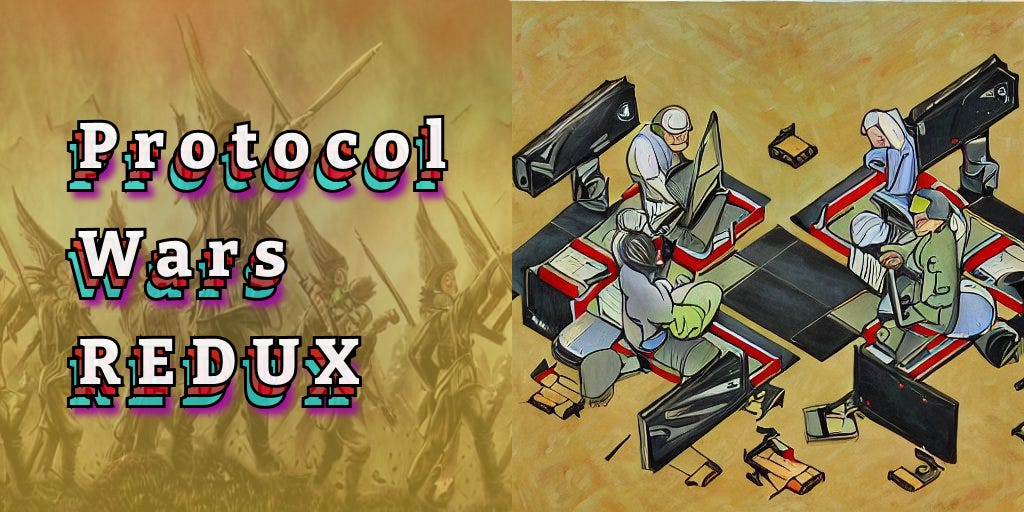History is repeating, as it so often does. There are more Metaverse standards bodies forming, with seemingly duplicative stated intent. I am happy to see interoperability taking more center stage in Metaverse conversations. However, when we bifurcate ourselves over and over, it becomes more difficult for us all to succeed. It’s great that users can take a sword from one realm to another on your platform. I can do that in Skyrim, Deep Rock Galactic, and fortnite. That is not interoperability.
Gaslighting each other, and pretending other standards bodies don’t exist, is a major risk to the Metaverse as a whole. This leaves us in tattered shatters, for the big players to swoop in with acquisitions, hostile takeovers, or something else entirely: in the name of “our resources, and experience.” I can’t tell you how many times I have seen true Open Metaverse champions forced to walk away because they “have to get a job.” Sadly, when you are talented and want to get paid what you deserve, you have to seek out the bigger corps. These bigger corps have rotten IP clauses in their employment contracts.
We are not doomed however, there are several pathways forward where everyone can feel like the juice was worth the squeeze.
Ego and IP
There are two major challenges to interoperability. Ego, and Intellectual Property (IP). I am not a lawyer, and I don’t really like when people have Metaverse patents, it just puts a metallic taste in my mouth. But I believe in the patent system, and I believe in your right to decide the fate of your IP. So… let’s talk about the bigger beast: Ego.
Open Metaverse Interoperability Group (OMI) emerged from an acknowledgment that multiple people would have the same ideas, most would have their own seemingly novel approaches to implementation, and sadly, many of them would fight to the death for supremacy. I mean imagine getting credited as a founding champion who brought forth the infinite digital parallel to our own Universe. There is perhaps no greater God complex than the one steeped in the Metaverse’s potential. You have to ask yourself, do you care more about the Metaverse being interoperable, or about getting credit as the person who started the group that made it interoperable?
We chose to make these protocols together because together we can more accomplished, and the more adoptors of these protocols, the greater the potential for all of us. We truly believe that we will continually attract bigger orgs, donors, and implementers. Our doors are always open.
This really meant that we would likely see new protocol wars emerge. I took off from work on March 31, 2021, and sent out a tweet asking for help. I said I can’t do this alone, and even if I did build interoperable products, who is to say any of these platform owners I have come to know would even implement them? After all, they can do it better themselves, their way, without outsiders stepping on their processes, and they can get hailed as the creator of the sticky bits that made it all work. Again, the sticky bits are the only way we even have a Metaverse at all. A metaverse platform without integration or interoperability is basically a video game.
I feel for the startups who are building in stealth right now, who genuinely believe they are creating “interoperable products,” in isolation. People aren’t going to want to build on your SDK bud. You need to use open standards so that you aren’t as threatening or annoying for the other builders in our space. Furthermore, there are ways to get your special protocol adopted by open communities.
Did you know you can literally submit your draft protocols to OMI for review, refinement, implementation, and ultimately formal ratification? We don’t work in isolation either. In fact, if your product has solved for a novel interop solution, say… you have crafted a draft extension for injecting personality into glTF objects and you would be better off if more platforms adopted the same standard. Maybe you make realistic NPCs, talking books, or a real-life Navi from the Ocarina of Time. You can literally submit your draft, and the OMI community will review it. We want to promote your protocol, so come on out of stealth and start collaborating. Or fail spectacularly and blame it all on something else, your choice.
1980s and 1990s
The Protocol Wars of the 1980s and 1990s refer to the competition between different networking protocols for dominance in computer networking. During this time, several networking protocols were developed and standardized, each with its own advantages and disadvantages. Some of the most notable protocols during this time include TCP/IP, IPX/SPX, AppleTalk, and NetBIOS.
The outcome of the Protocol Wars was significant, as it determined which protocol would become the standard for communication between computers, thereby shaping the development of the internet. Ultimately, TCP/IP emerged as the dominant protocol, paving the way for the widespread adoption of the internet as we know it today. Wikipedia has a great page on the Protocol Wars of the past.
This pattern has persisted in Product as well. We have seen the rise and rapid fall of HD DVD to the victor Blu-Ray, Zune fell to iPod, yahoo search is nowhere even close to google search volume. Supremacy is a big deal to corporations, and they will do whatever it takes to achieve it. Green text bubbles be damned!
Web3 today
There are Protocol Wars in Web3 today as well. The competition between different blockchain protocols to become the dominant platform for decentralized applications and services is no different than the Web2 challenges before them. This competition is primarily driven by differences in the technical design, governance, and economic models of the protocols, with various factors such as security, scalability, and community support being considered.
Some of the notable players in the Protocol Wars include Ethereum, Binance Smart Chain, Polkadot, and Solana, among others. The outcome of the Protocol Wars will have significant implications for the future of decentralized technology and its impact on the broader economy. Blockchain technology needs interoperability, and this can work if they focus on the web3 bits and not the entire Metaverse. See if a web3 standards body starts creating Avatar Interoperability protocols, that isn’t really necessary. Avatar interop protocols should be defined for use both on and off chain. For example, glTF is a collaborative file format organized by the Khronos group.
Web Standards Bodies today
There are several major standards bodies that govern the protocols and standards of the web today. Some of the most prominent ones include:
World Wide Web Consortium (W3C): The W3C is an international consortium dedicated to the development of web standards. It is responsible for setting and maintaining the standards for HTML, CSS, and JavaScript, among others.
note: OMI is actually affiliated with W3C. The Metaverse Interoperability W3C working group is about half of what makes us OMI.
Internet Engineering Task Force (IETF): The IETF is a large, open, international community of network designers, operators, vendors, and researchers concerned with the evolution of Internet architecture and the smooth operation of the Internet. It is responsible for the development and maintenance of various Internet protocols, such as TCP/IP, HTTP, and DNS.
Internet Assigned Numbers Authority (IANA): IANA is a department of the Internet Corporation for Assigned Names and Numbers (ICANN) and is responsible for maintaining the central coordinating functions of the Internet's system of unique identifiers. This includes the management of IP addresses and domain names.
ECMA International: ECMA International is a standards organization for information and communication systems, responsible for standardizing technologies such as JavaScript and JSON.
These standards bodies play a crucial role in ensuring the interoperability and compatibility of web technologies, enabling the seamless functioning of the Internet as we know it today.
A quick case for Metaverse interoperability
It’s going to get even more confusing for builders to contribute to the Metaverse if they are forced to choose between Microsofts physics body extension, versus Epic games physic body extension, versus Apples physics body extension, etc. Building one wearable, may require multiple refactors to reach the desired audience. This is true today for application developers who want to see their product on the Apple app store, Google Play, and others.
Users are frustrated with the walled gardens (unless you are a non-technical Apple user, then you may be just fine with your walled garden). We have seen games like Fortnite completely rock the world by offering a free, cross-platform game that anyone can play, on almost any device. Pretty much as low of a barrier to entry as it comes.
With over 500 million registered epic games accounts registered by late 2022. Fortnite generates billions of dollars per year, largely from the sale of digital assets. This digital asset marketplace is likely to become the most valuable business in the Metaverse in my opinion. A true, interoperable Metaverse marketplace would require widespread adoption by users, widespread asset contribution by builders and IP owners, and widespread implementation by Metaverse platforms and virtual worlds. To even get to that point, we need a common ground, unless you enjoy having 15 streaming services (Netflix, Hulu, HBO Max, etc.) and want to have 15 different Metaverse inventories as well (Epic games, Microsoft, Apple, Webaverse, FrameVR, Cryptovoxels, etc.)
Enter the Metaverse Collaborative Communities and Standards Bodies
In the Angell XR community, we didn’t want to sit around and wait for the big companies to decide Metaverse interoperability standards for us. We have always been pretty biased in favor of web-first, platform agnostic, and hardware agnostic solutions. The era of Playstation versus Xbox, Apple versus Microsoft, and Desktop versus console is all becoming increasingly irrelevant. Once again, it seems ego is bifurcating our efforts. New standards bodies emerge every 3-6 months at this rate. Each with a similar statement of intent, or vision, declaring that their efforts are to promote an open, interoperable, accessible, human-centered, Metaverse for all. I mean hell yeah! Who doesn’t resonate with that? Thing is, did you look at any other standards bodies to see if you could pledge your resources there first? Or was it easier to just hit the ground running, and conduct no research? The ole ignorance is bliss business model.
When you pierce the veil of these emergent standards bodies, it is generally closer to a Potemkin village. There are usually only 2-5 people behind the scenes, propping up marketing campaigns, websites, sign-up forms, and a series of Twitter spaces. They generally have the backing of a group with deep pockets, and strong opinions or a vested interest in locking down their corner of interoperability standards. Three things usually follow:
they rally around some core values (yay!)
they form working groups and start recruiting collaborators to join (sensible!)
they decide they need funding "to move faster,” so they find donors, or form a membership model. (ok…)
This is because it is hard to find people to work for free. It just is. And when you start muddling in too heavily an influence of for-profit, people lose faith in your intentions. Reject all for-profit interests, and you lose sustainability. See there are more forms of payment than an immediate monetary return. Starting a successful open-source project comes with reputational gains that are invaluable.
Creating a community that aligns differing opinions around common values is the real recipe for success. When you exclude the for-profit entities or blockchain entities, they go form their own standards bodies. People like existing in echo chambers, it’s so warm and fuzzy surrounding yourself with other versions of yourself. This is not diversity, this is not resilience, and this is not conducive to an open Metaverse.
Do you care more about the Metaverse being interoperable, or about getting credit as the person who started the group that made it interoperable?
It doesn’t usually start as a pay-to-play model, but it often goes in that direction. This vastly excludes a large portion of Metaverse builders. Your niche web3 standards org is not helping the World, it is creating a web3 exclusive, a separation, a division. Your protocols are useless unless everything is on-chain. That will never happen. Your membership model is not helping to save the World. It is helping the pay-to-play orgs with massive war chests dig deeper lines in the sand. After all, they are rich, shouldn’t they decide the fate of the digital universe!? Fuck no.
FOSS vs. Open Source
Open source software refers to software whose source code is made available to the public, allowing anyone to view, use, modify, or distribute the code. This allows for collaboration and innovation in the development of the software.
Free and Open Source Software (FOSS) refers to open-source software that is not only free of charge but also free to use, modify, and distribute as desired. The "free" in FOSS refers to freedom, not just the absence of cost. FOSS is developed by communities of volunteers and is typically maintained and updated by the community. The goal of FOSS is to promote collaboration, sharing, and innovation in software development.
In summary, all FOSS is open source, but not all open-source software is FOSS. The key difference is that FOSS emphasizes freedom, whereas open source simply refers to the availability of the source code.
I will do a follow-up piece on the abuse of the term “Open Metaverse,” by literally dozens of groups, both real and Potemkin.
Free as in Free
In the open-source community, the term "free" is often used to refer to different aspects of open-source software. Here are some of the common interpretations of "free" in the context of open source:
Free as in freedom: This refers to the freedom to use, modify, and distribute the software as desired. The focus is on the users' freedom to control and customize the software to meet their needs, rather than the absence of cost.
Free as in beer: This refers to the software being available at no cost, i.e. “come in on Tuesdays at 5 pm for free beer!”. This interpretation of "free" is often used in contrast to proprietary software, which must be purchased.
In conclusion, the interpretation of "free" in the context of open-source software can be nuanced, and it's important to understand the different forms of "free" in order to fully appreciate the goals and benefits of open source. The main difference is between something that is free of charge and freedom.
Standards bodies should cross-pollinate more
Standards bodies will continue to emerge until they start to merge due to resource constraints, proven success in collaboration, or backroom deals. This is inevitable because we are human. The best path forward is for these standards bodies to collaborate together. This is what I thought Metaverse Standards Forum (MSF) would be, a watering hole for us to come togehter. Thing is, they too ultimately formed their own working groups, and are debating a membership model. They don’t intend to be a standards body, but who knows if that will hold true in say… 5 years, as new contributors with new ambitions re-shape the identity. It is important to note that MSF successfully attracted larger players to consider open standards though, which is good for all of us in my opinion.
OMI actually has a handful of collaborators we refer to as “MSF delegates”. They attend the MSF meetings, report back to the OMI community about upcoming initiatives and critical votes, and ensure that we as OMI are productive contributors to the MSF community. I would like to see other standards bodies doing the same, our doors at OMI are open, and we would love to send delegates to attend your meetings as well. For example, the OMI Avatar interop group is actually organized and hosted by M3. Why would we form an avatar interop group, when there is one within reach at M3?
When Open Metaverse Foundation (OMF) announced they are forming, we had a sneak preview in an OMI weekly meeting. The lead of the effort attended an OMI event and shared their intentions with our community. We immediately had a volunteer offer to attend OMF meetings on behalf of OMI. Even if we are working on literally the same thing, we can ensure that we are lock-in-step, and headed in the same direction, together.
Conclusion
You can use and contribute towards open standards, without open-sourcing your software. There are constant trade-offs between business value, user value, and builder value, and you must choose the model(s) that work best for your intent. However, when you call your product open source, and it is proprietary, you are doing more harm than good to your own brand, and to the open source communities as a whole. We will cover this more in a future article.
Thanks for reading this far! I am still getting comfortable writing and creating these videos. Sometimes I make mistakes, but I am learning! If you liked this article, please consider subscribing and sharing. Let’s build the open Metaverse, together.








